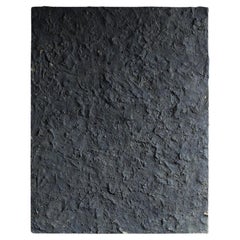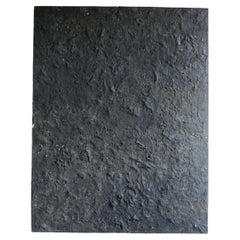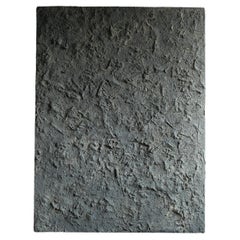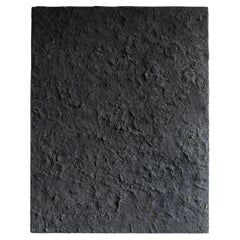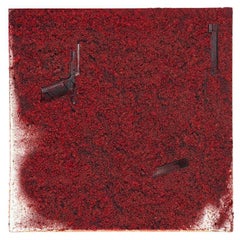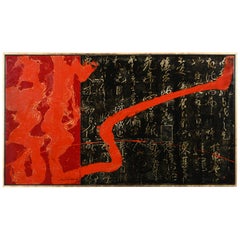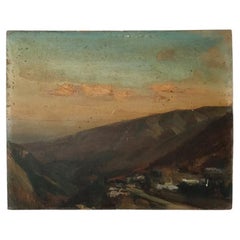Clay Paintings and Screens
to
1
5
1
5
4,305
765
736
701
525
4
4
4
1
1
5
4
4
1
Material: Clay
Tsumikasanattamono by Wataru Hatano BK Small_A
Located in Sammu-shi, Chiba
Japan / 2021s
Size : W900 D25 H1200 mm
Kuroya Washi artist Hatano Wataru's masterpiece "Stacked Things" series. Japanese paper, soil, pigments, etc. are layered on top of each other to express the beauty of what has been accumulated over the years.
[Wataru Hatano...
Category
2010s Japanese Japonisme Clay Paintings and Screens
Materials
Sandstone
Tsumikasanattamono by Wataru Hatano BK
Located in Sammu-shi, Chiba
Japan / 2021s
Size : W1200 D25 H1550 mm
Kuroya Washi artist Hatano Wataru's masterpiece "Stacked Things" series. Japanese paper, soil, pigments, etc. are layered on top of each other to express the beauty of what has been accumulated over the years.
[Wataru Hatano...
Category
2010s Japanese Japonisme Clay Paintings and Screens
Materials
Sandstone
Tsumikasanattamono by Wataru Hatano
Located in Sammu-shi, Chiba
Japan / 2021s
Size : W1200 D25 H1600 mm
Kuroya Washi artist Hatano Wataru's masterpiece "Stacked Things" series. Japanese paper, soil, pigments, etc. are layered on top of each other to express the beauty of what has been accumulated over the years.
[Wataru Hatano...
Category
2010s Japanese Japonisme Clay Paintings and Screens
Materials
Sandstone
Tsumikasanattamono by Wataru Hatano BK Small_B
Located in Sammu-shi, Chiba
Japan / 2021s
Size : W900 D25 H1150 mm
Kuroya Washi artist Hatano Wataru's masterpiece "Stacked Things" series. Japanese paper, soil, pigments, etc. are layered on top of each other to express the beauty of what has been accumulated over the years.
[Wataru Hatano...
Category
2010s Japanese Japonisme Clay Paintings and Screens
Materials
Sandstone
Harmonious Disarmament
By John Brevard
Located in Coral Gables, FL
this avant-garde sculpture emerges as a poignant narrative, a dialogue between the rawness of natural elements and the stark reality of human conflict. Crafted meticulously from clay...
Category
2010s Virgin Islands Modern Clay Paintings and Screens
Materials
Sandstone
$16,880
Related Items
Signed Huang Gang Chinese Modernist Painting, 2003
Located in Hamburg, PA
Huang Gang (Chinese b. 1961) a monumental painting done in Chinese lacquer and mineral pigment on board, signed "Huang Gang, 2003". In good condition with a...
Category
Early 2000s Chinese Modern Clay Paintings and Screens
Materials
Wood, Giltwood, Paint
Morning of Gora Antique Japanese Oil Painting by Masuta Narahara
Located in Chiba, JP
Antique Japanese oil painting on wooden board, titled ‘Morning of Gora (Hakone, Japan)’, by Masuta Narahara (1888-1963). 27 x 21.5 x 0.5 cm (10.62 x 8.46 x 0.19in). Aged deteriorati...
Category
Early 20th Century Japanese Japonisme Clay Paintings and Screens
Materials
Wood
Rare Triptych Scroll Paintings by Watanabe Seitei Meiji Period
Located in Atlanta, GA
A set of three paintings of ink and watercolor on silk mounted within brocade borders as scrolls by Watanabe Seitei (1851-1918). This is a very rare an...
Category
Early 1900s Japanese Japonisme Antique Clay Paintings and Screens
Materials
Brocade, Silk, Wood
Vintage Roman Column 6 Panel Architectural Incised Privacy Screen Room Divider
Located in Wayne, NJ
Large decorative 6 Panel Architectural privacy screen room divider. Will go well with style decor . From Traditional to Modern. This is a heavy in weight piece. Many details are inc...
Category
1970s Unknown Modern Vintage Clay Paintings and Screens
Materials
Brass
$5,000 Sale Price
28% Off
H 84 in W 96 in D 1 in
Antique obi textile art " Pine forest ~ Longivety ~ " by ikasu Green , Japan
By Kimono ikasu
Located in Setagaya City, JP
<< Story behind the work >>
Obi fabric I used for this artwork is taken from three different over 100-years-old antique sashes, and is framed in wood taken from antique chest-of-dra...
Category
Early 20th Century Japanese Japonisme Clay Paintings and Screens
Materials
Gold Leaf
$3,800
H 33.86 in W 39.38 in D 1.58 in
Vintage kimono textile art " Growing ~ Longevity ~ " by ikasu Pink, Japan
By Kimono ikasu
Located in Setagaya City, JP
<< About this canvas >>
This set is a depiction of a tall chrysanthemum stem, entirely dyed in a traditional shibori technique.
<< Period / Story >>
The haori featured in this canvas was created and used during the late Showa period (1960-80ies).
<< Explanation and meaning of pattern and colors >>
A charming chrysanthemum flowers all around a stem seem to reach the heavens.
The chrysanthemum flower, which retains its vitality long after being cut, symbolizes longevity, purification from malevolent spirits, and good fortune. In ancient times, during the Kamakura period (1185-1333), emperors loved the chrysanthemum pattern, and it remains the most prestigious flower and the emblem of the Japanese imperial family...
Category
1970s Japanese Japonisme Vintage Clay Paintings and Screens
Materials
Canvas, Silk
$720
H 31.5 in W 13.39 in D 0.79 in
Antique kimono textile art " Waves and clouds ~Eternity~ " by ikasu Beige, Japan
By Kimono ikasu
Located in Setagaya City, JP
This work is inspired by traditional hand-dying technique edo-komon, and is framed in paulownia wood originally used for a kimono chest-of-drawers.
It is elegantly framed with paulo...
Category
1920s Japanese Japonisme Vintage Clay Paintings and Screens
Materials
Silk, Wood
$3,000
H 33.47 in W 24.81 in D 1.97 in
ICHIMATSU by Blue Tip atelier
Located in Sammu-shi, Chiba
Title : ICHIMATSU
Japan / 2020s
Size : W 1480 x H 1480 mm
Each part is dyed with indigo to express a checkered pattern that collapses. This quilt is made with Woven fresh linen. Hand-quilted with cotton thread. Hand dyed with indigo.
[Blue Tip atelier...
Category
2010s Japanese Modern Clay Paintings and Screens
Materials
Linen
Vintage 20th century Japanese Nude Charcoal Nihonga Drawing by Eiki Tsukioka
Located in Chiba, JP
Charcoal on layered washi (Japanese paper) stuck on wooden canvas, 53 x 65.5 x 1.5cm (20.86 x 25.78 x 0.59in), by Eiki Tsukioka (1916-1997), as one of the leading Showa’s Nihonga (J...
Category
20th Century Japanese Japonisme Clay Paintings and Screens
Materials
Paper, Wood
$250
H 25.79 in W 20.87 in D 0.6 in
Rare Antique Japanese Folding Screen by Kano Tanshin
By Kano Tanshin
Located in Atlanta, GA
An exquisite Japanese folding screen painted and signed by Kano Tanshin (Morimasa) (1658-1719), circa early Edo Period. An important member of the Kano painter family, the son of Kano Tanyu...
Category
17th Century Japanese Japonisme Antique Clay Paintings and Screens
Materials
Brass
Antique kimono textile art "Prosperity Tree" by ikasu Black, Japan
By Kimono ikasu
Located in Setagaya City, JP
This work uses an antique kimono fabric dated Taisho era (early 1910th), with a pine tree motif, and arranges it so that it looks like a tree decorated with various auspicious symbols - persimmons, pines, peonies, etc.
The line in the middle symbolizes “kintsugi” - concept of wabi-sabi, which values imperfection, impermanence, and the beauty of aging.
It is elegantly framed with paulownia wood originally used for kimono chest-of-drawers, and is filled with storytelling and sense of luxury.
I used pieces of kimono that could no longer be used as clothing and kiritansu chest-of-drawers that would normally be discarded to create the ultimate upcycled piece.
<< Explanation and meaning of pattern and colors >>
The art work features the matsu - pine pattern, which depicts the Japanese pine tree spreading over deep black fabric. It appears as if the pine dranches are decorated with various auspicious symbols - persimmons, pines, peonies, etc.
In East Asia, the pine tree is revered as a symbol of longevity due to its vibrant green leaves, even during the winter season.
In Japan, it's often referred to as the "evergreen tree" because its leaves remain green throughout the year, making it a symbol of good fortune that has been cherished for a long time.
<< Characteristics of the fabric >>
The fabric is hand-painted in traditional Japanese technique "yuzen".
<< About the frame >>
Kiritansu - chest-of-drawers for kimono, is traditionally made from paulownia wood, a uniquely Japanese material closely tied to the world of kimonos.
Paulownia wood is known as the lightest wood in Japan, prased for its natural luster, resistance to moisture, and resilience against cracking. Since ancient times, it has been used in crafting furniture, chests, and musical instruments.
During the Edo period, it became customary to store cherished kimonos in paulownia chests...
Category
Early 20th Century Japanese Japonisme Clay Paintings and Screens
Materials
Gold Leaf
$2,200
H 28.75 in W 20.87 in D 1.97 in
Japanese Modernist Painting of a Seaside Village by Torao Ataka Dated 1930
Located in San Francisco, CA
A Modern oil painting of a harbor town with the water and mountains views in the distance.
It is signed on the bottom left hand corner Ataka and dated '30 (1930).
The brushwork is ...
Category
1930s Japanese Modern Vintage Clay Paintings and Screens
Materials
Canvas, Paint
$1,295
H 19.75 in W 24 in D 1.5 in
Recently Viewed
View AllMore Ways To Browse
Japanese Red Lacquer Frame
Lattice Panel Wood
Hanging Japanese Screen
Japanese Lattice
Japanese 19th Century Meiji Period Silk Painting
Japanese Buddhist Screen
Japanese Carved Screen
Japanese Screens And Doors
Monkey Screen
Japanese Autumn Screen
Japanese Screens Six Fold
Japanese Wood Room Divider
Kyoto Silk Painting
Japanese Dragon Painting
Japanese Birds Painted On Silk
Heian Period
Japanese Crane Panel
Japanese Divider Screen
